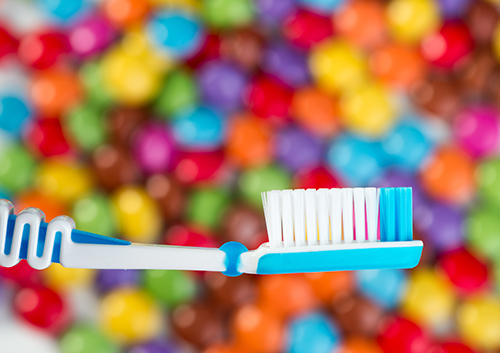December 30th, 2020

Oral hygiene has always been an important part of maintaining overall health. For thousands of years, humans have found ways to keep their teeth and mouths clean. According to the American Dental Association (ADA), “early forms of the toothbrush have existed for nearly 5,000 years.” But what exactly did the first toothbrush look like?
Toothbrush Timeline
With help from The Library of Congress, Dr. Hudis and our team have compiled a timeline with some interesting details about the evolution of the toothbrush:
- 3000 BC – Perhaps the earliest form of the toothbrush, the “chew stick” was used by Ancient civilizations. People would rub this thin twig with a frayed end against their teeth to remove food and plaque.
- 1498 – The bristle toothbrush was invented in China and had many similarities to the toothbrushes used today. These devices were made by attaching the stiff, coarse hairs from the back of a hog’s neck to handles that were typically made from bone or bamboo.
- 1938 – Signaling the end of the boar bristle, Dupont de Nemours introduced nylon bristles, and Americans welcomed Doctor West’s Miracle Toothbrush, the first nylon toothbrush.
- 1960 – The Squibb Company introduced Broxodent, one of the first electric toothbrushes, to the American market.
Toothbrushes Today
Today, there are many brands of toothbrushes that often advertise different benefits. The variety of options may seem overwhelming, but the most important thing is for you to find a toothbrush that you like and find easy to use.
The ADA recommends that you choose a toothbrush that fits comfortably and allows you to effectively reach all areas of your mouth. Whether you decide to use a manual or a powered toothbrush, make sure that you thoroughly clean all surfaces of your teeth twice a day.
Society has come a long way since the days of the chew stick, but one thing that remains the same is the importance of consistent and effective personal oral hygiene.
December 23rd, 2020

In your golden years, you’ve become a pioneer in tooth care. Yours is probably the first generation in history that can expect to keep most of their natural teeth for a lifetime. You can probably guess the reasons: better oral care, advances in dentistry, improved nutrition, and a lower risk for diseases that could weaken teeth and gums.
As a pioneer, you’re learning with your dentists, and one thing we’ve found is that teeth change with age, just like the rest of the body. Even if your teeth can remain strong and white, here are a few things you may have to cope with:
Cavities: Tooth decay is not just for kids anymore. Seniors often develop cavities on the lower part of the tooth near the root. Thorough flossing and brushing along the gum line is the best preventive measure.
Sensitivity: Gums recede over time, and good dental habits only slow the process. Receding gums leave more of each tooth exposed, and the newly uncovered areas have less enamel. As a result, these teeth may be much more sensitive to hot and cold. If you find your teeth become more sensitive, try a toothpaste designed for sensitive teeth and be sure to tell Dr. Hudis about it at your next checkup.
Difficulty brushing: If you have arthritis or limited motion you may have a hard time brushing your teeth. Consider switching to an electric toothbrush. There are also assistive devices available that make it easier to grip a manual toothbrush.
Other health problems: Diabetes, heart disease, and other chronic illnesses can cause symptoms in your mouth. Be sure to let us know if you have any health conditions, or if your condition changes. We can help treat symptoms that affect your teeth and recommend ways to maintain good oral health habits as part of your overall health program.
December 16th, 2020

Many people are confused when it comes to which specialist they need to see about their dental needs. However, it is a simple decision depending on what your individual needs are. For example, a dentist performs routine cleanings and addresses all issues with filling cavities etc. Some of general dentists can also perform other procedures such as bridges and crowns, and some even refer to themselves as a cosmetic dentist.
Typically any dentist can refer to themselves as a “cosmetic dentist” however, a prosthodontist, like Dr. Hudis, is actually educated for an additional three years to know how to correctly perform cosmetic dentistry, bridges, dentures, crowns, and implants.
After successfully completing a four-year dental degree, those who choose to become a prosthodontist will have to attend an additional three years. During these three years they are educated extensively on everything that has to do with prosthetics involving the mouth. They will be able to perform all bridge work, crowns, implants, and dentures. They also will be able to successfully lead any other team of dentists you may be seeing to get you the best possible treatment.
A general dentist chooses not to specialize in any particular area. While they may be proficient at many dental procedures, they may still refer patients to our Princeton, NJ office for more complicated procedures, including:
- Treatment due to injuries
- Snoring disorders
- Cleft palate or related issues
- Joint problems such as TMJ
- Maxillofacial prosthetic procedures
- Full mouth reconstruction
- Cosmetic issues
If you have an issue that you are not sure who is best to treat, keep in mind that, although both are able to treat a multitude of issues, only prosthodontists receive the education and training to specialize in more serious issues.
December 9th, 2020

Inflamed gums are a fairly common dental issue, but unfortunately, many people don't take the problem seriously enough. If you ignore inflamed gums and continue your usual routine, you could be encouraging a much more severe inflammation problem, and the pain that goes along with that. Fortunately, it is quite easy to relieve inflamed gums if you use the tips below.
Use Soft Bristles
A soft-bristle toothbrush - the softest you can buy - is a must for anyone with inflamed gums. Anything that makes contact with your gums can cause you pain, so fine and soft bristles are always the best choice.
Use Sensitive Formula Toothpaste
The toothpaste marketed as “Sensitive Teeth Formula” contain special ingredients to help relieve sensitivity. When your gums are inflamed, even light brushing can cause some pain. Using a special toothpaste will help reduce that pain and make it easier to brush your teeth effectively. The effect becomes stronger as you use the toothpaste more, so use it for each brushing.
Visit Our Office
If your gums remain swollen for more than a few days or a week, set up an appointment with Dr. Hudis. There is a long list of conditions that could be causing your swollen gums, everything from gum disease to pregnancy, so you need to find out where your issue is coming from. Most of the time, Dr. Hudis can easily treat the swollen gum issue at our Princeton, NJ office, or can give you an effective treatment to take home.








